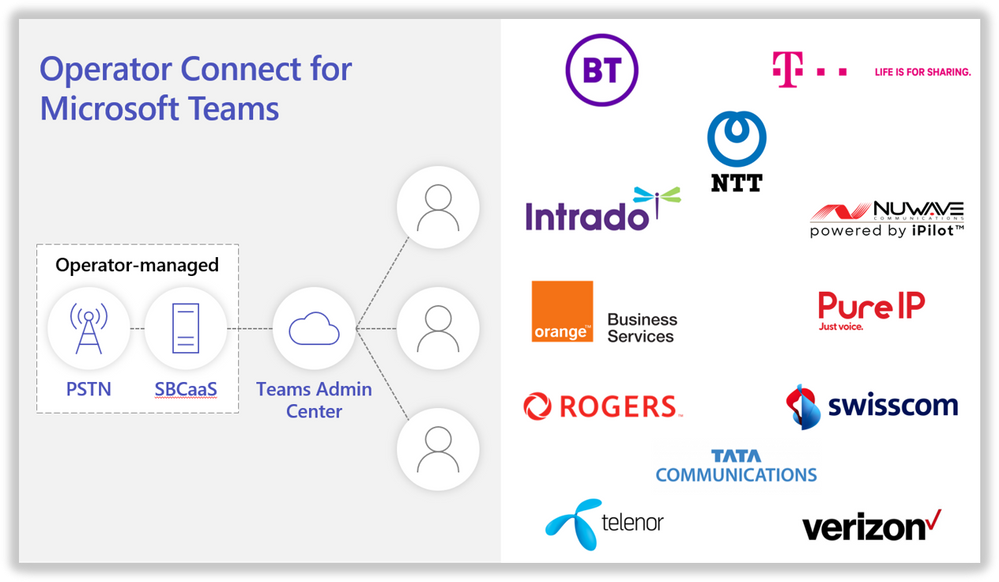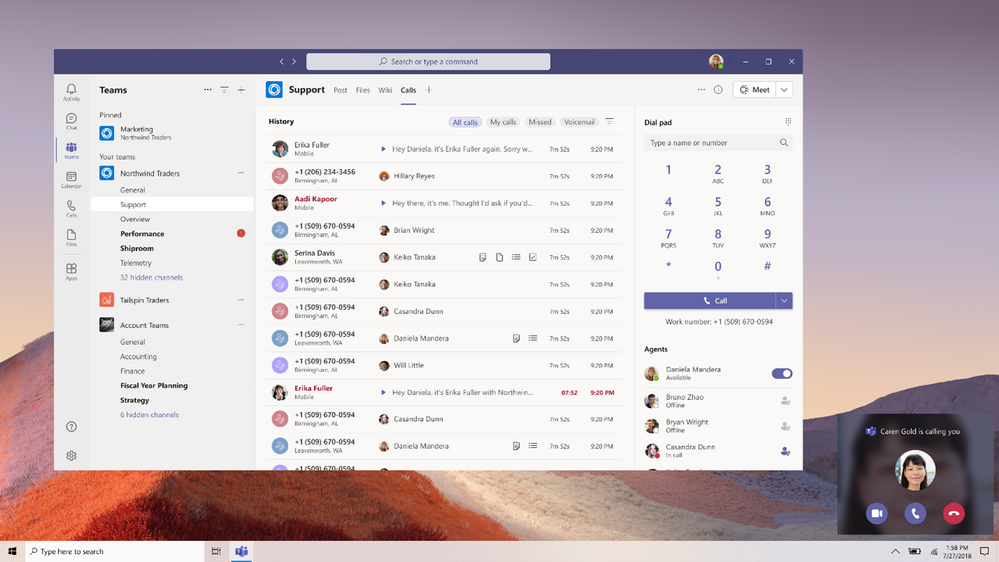Voices matter – and we think that Microsoft Teams Calling is a powerful way to use those voices to strengthen connections and build new ones. The hallway chats and informal customer conversations that we used to rely upon now need to happen digitally, reinforcing the need for a modern and seamless calling solution. In fact, Microsoft recently announced that Teams users placed over 650 million calls in October, up 11 fold from just a few months earlier in
Microsoft is committed to building a modern calling solution that is simple and quick to deploy – for example with innovations like Operator Connect. The updates shared here represent just some of their
Simple and seamless options to add PSTN calling to Teams
Operator Connect

Microsoft’s commitment to creating a
- Leverage existing operator contracts: Keep your preferred operator and contracts, while enabling a modern calling experience
in Teams - Simple and quick to deploy: It can take just minutes to connect to your operator and assign phone numbers to users – all from the Teams Admin Center. You do not need to be an expert in voice to deploy calling
to Teams - Operator-managed infrastructure: PSTN calling services and Session Border
Controllers (SBCs) are managed by operators, saving on hardware purchaseand management - Enhanced support and reliability: Operators provide tech support and shared service level agreements to improve support service, while direct peering powered by Azure creates a 1:1 network connection for
enhanced reliability
When Operator Connect launches, Admins will be able to open the “Operators” tab in the Teams Admin Center, where qualified operators will be listed. Admins can then select their preferred operator and connect calling services, at which point they can acquire phone numbers from these operators and assign them to
Operator Connect will enter public preview next quarter with the initial wave of partners which includes BT, Deutsche Telekom, Intrado, NTT, Nuwave, Orange Business Services, Pure IP, Rogers, Swisscom, TATA, Telenor, and Verizon. Microsoft has been working in close partnership with these operators to create a seamlessly integrated experience, and they will add additional partners to the Operator
Microsoft Teams Calling Plans market expansion

Microsoft Teams Calling Plans provide a quick and simple way to deploy calling in Microsoft Teams with no
To enable more Teams users to take advantage of Microsoft Teams Calling Plans, Microsoft is expanding availability to 8 new markets beginning this month and completing by the end of June. The new markets are
Direct Routing updates
As more and more of Microsoft customers are turning to Teams for their calling solution, their use of Direct Routing has expanded significantly – over just the past year, Direct Routing call minutes have grown
To provide organizations with choice and flexibility for their Direct Routing deployments, Microsoft is continuing to add to the list of Session Border
Operator Connect Conferencing

Furthermore, to enable more options for conferencing, Microsoft is announcing Operator Connect Conferencing, a new service that uses the same administrator interface as Operator Connect and allows you to add operator
Operator Connect Conferencing is an
- Bring your own operator for conferencing, for operators participating in the program: Maintain your preferred operator contracts as you migrate existing PSTN infrastructure to
the cloud. - Variety of operators available at your fingertips: Diversify your PSTN infrastructure to include additional
qualified operators. - Expanded geographic
dial-in coverage: Additionaldial-in locations available to support yourmulti-national needs. - Enhanced support and reliability: The tight partnership with operators provides enhanced technical support and service level agreements to
address reliability.
Operator Connect Conferencing will enter private preview next quarter with the initial wave of qualified partners, which includes BT, Deutsche Telekom, Intrado, NTT, Orange Business Services, and Telenor. Microsoft has been working in close partnership with these telecom operators to create a seamlessly integrated experience and they will add more qualified operators
Innovative value for broad & sophisticated calling scenarios
Voice-enabled channels

Many teams tackle calling as part of their workflows, and often collaboration can yield better and faster results.
Enhanced Calls app experience
Teams is the hub for chat, collaboration, meetings, apps, and workflows, and the enhanced Calls app brings the most important calling elements – the dial pad, call history, voicemail, contacts, and settings – into a single location, making it easier to stay connected in the flow of your work. Last month, Teams users saw this new experience in their
Certified Contact Center and Compliance Recording solutions
Teams is an extensible platform, and that applies to Teams Calling as well. The Teams Contact Center certification program and Compliance Recording certification program can help customers feel confident that their preferred contact center and compliance recording solutions integrate seamlessly and reliably with Teams. Microsoft is pleased to share that Anywhere365, ComputerTalk, 8x8, and Enghouse Interactive have achieved contact center certification for their solutions. Additionally, NICE, AudioCodes, Dubber, ASC, Numonix and Verint have achieved compliance recording certification for
Endpoint transfer
Teams makes it easy to place and receive calls from several different endpoints, including desktop and mobile devices, but sometimes you need to move locations or devices to finish your call. The new endpoint transfer capability will allow you to seamlessly move your calls between different devices, such as from your laptop to mobile phone, without any interruption in call service or quality. Endpoint transfer will be available early
Low-data mode
Whether you want to preserve data or are just in a location with a poor or limited network connection, sometimes it’s helpful to limit the amount of data you’re using during a meeting or call that uses video. A new low data mode is now available, allowing users to cap the amount of data that will be used during Teams meeting or video calls, as well as establish different settings based on network availability so that the setting can be turned on always, or only while on
Bandwidth control
Many organizations have limited bandwidth capacity at locations on their network and require the ability to restrict Teams bandwidth consumption at those locations. The new bandwidth control feature will permit Teams Admins to proactively establish network bandwidth consumption for Teams clients at specific network locations – for example, a low bandwidth control limit for remote locations and higher limits for other sites. Bandwidth control capabilities will be available early
Flexible and powerful calling endpoints
SIP Gateway
For supported SIP phone models, Microsoft is excited to introduce the preview of their SIP Gateway solution, which will enable core Teams calling functionality on legacy phones from Cisco, Poly, Yealink and AudioCodes. Capabilities may include inbound and outbound calls, call transfer, dial in/out to meetings,

New calling form factors

Two new phones, the Yealink MP52 and AudioCodes C435, will be generally available by this month. These new form factors provide a simplified Teams phone experience with core calling functionality, at a more affordable price point. These offerings make for excellent desk phones or common
Remote deployment for common area phones
Remote deployment is now available for common area phones. Within the Teams Admin Center, IT Admins can add a phone into the device inventory using a device
Teams display enhancements
There are exciting new enhancements to the Teams display experience on the Lenovo ThinkSmart View. Teams display allows users to stay in the flow of work with convenient access to collaboration updates and short cuts to their meetings and calls. Microsoft has added background replacement and live reactions to meetings as well as the ability to send quick responses and reactions to chats from the
Most exciting are Microsoft’s new Bing and Cortana integrations which allow users to fetch useful information from the internet that can help them stay prepared for their meetings and calls. Use Bing to ask
- “What time is it in New York?”
- “What is the weather in Seattle?”
- “How many pesos are in a dollar?”
To learn more about the devices, visit aka.ms/TeamsDevices.
Device-as-a-Service expansion
Microsoft is excited to announce an expansion of their monthly financing plans offered through their
Try Teams Calling for free and get support with your deployment
With all these capabilities launching, it’s important to keep in mind that Teams Calling can be rolled out in weeks – not months or years – as Lumen (formerly CenturyLink) showed by rolling out Calling globally to over 40,000 users in
- Start with a free trial (aka.ms/e5trial for organizations ≥300 users, or aka.ms/BusinessVoiceTrial for
<300 users) - Get guidance and resources from FastTrack as you roll out
Teams Calling - Check out additional Teams Calling customer stories to hear how organizations from across industries are addressing critical business needs with
Teams Calling

